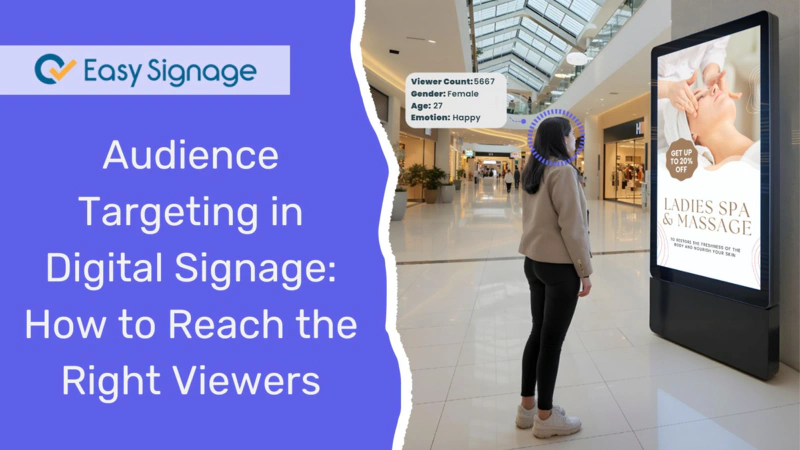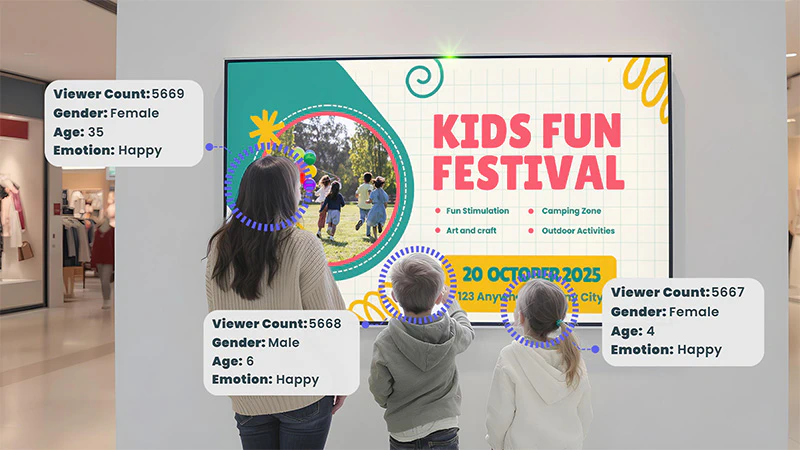Audience Targeting in Digital Signage: How to Reach the Right Viewers

Audience Targeting: From One Message to the Right Message
Have you ever noticed that sometimes when you walk past a screen, it seems to speak directly to you? Maybe it displayed a coffee offer just when you needed a caffeine boost or advertised sneakers right after your gym session. This isn’t a coincidence; it’s called audience targeting in digital signage.
Digital signage is not just about displaying visuals on a screen anymore; it’s now focusing on connecting with people. When screens display content that resonates with viewers, engagement with digital signage naturally increases.
Businesses can use audience targeting in digital signage to deliver targeted content to specific groups based on factors like age, gender, interests, or location. Instead of broadcasting the same message to everyone, they can customise what appears on the screen so that each viewer sees something relevant and valuable. This smart, data-driven approach improves communication, increases conversions, and creates personalised experiences that feel engaging and relevant to the audience.
In short, it’s all about showing the right message to the right people at the right time.
What is Audience Targeting in Digital Signage?
Audience targeting means customising the content that appears on your digital signage screens based on the viewers in front of them. When someone passes by a screen, the digital signage system uses artificial intelligence and cameras to detect demographics such as age, gender, or behaviour and automatically selects what content to appear on the screen, creating personalised digital signage.
The concept of audience targeting originally comes from digital advertising, where brands personalise online ads to match user profiles and interests. Now, AI-driven digital signage applies this same strategy to the real world, turning traditional screens into smart communication tools that interact with real audiences in their environments.
For example, a retail store can display different ads depending on who is standing in front of the screen, like promoting children’s products to families and showcasing tech gadgets to young adults.
How Audience Targeting Works
Instead of trying to guess what your audience wants to see, the system uses cameras and integrated data sources to identify the people near the screen and automatically adjust the content accordingly.
Let’s break down the process into simple parts, using how EasySignage does it:
Detecting the Audience / Data Collection
A connected camera anonymously scans the surrounding area to detect if someone is looking at the screen. It does not store any personal information (PII). The camera can estimate demographic attributes like age range and gender from up to about 6 meters away.
Edge AI Processing
The EasySignage audience targeting solution performs all analysis directly on the device, with no additional equipment required to send video to remote servers. This results in faster responses and decisions, less reliance on cloud systems, and better privacy.
Content Rules and Targeting Logic
In the EasySignage content management system (CMS), you can set rules for audience targeting. You can enable audience targeting for a specific media by defining an age range and selecting a targeted gender. Based on these parameters, the system automatically matches and displays the right content.
For example:
- If the viewer is female and aged 20–35 → the system will show the ad for “New Women’s Collection”.
- If the viewer is male and aged 40–60 → the system will display the ad for “Fitness Supplements”.
Real-time Display and Adaptation
One of the smartest features of AI digital signage is its ability to adapt content in real time. As the audience in front of a screen changes, the system automatically updates the displayed content.
For example, if a shopping mall screen detects a group of teenagers passing by, it might switch to an ad for sportswear or tech accessories. A few minutes later, when families approach, the screen could automatically display offers for a family meal or promotions for children’s activities. This quick adjustment happens seamlessly, without any manual input.
What’s even more impressive is that personalised digital signage does not depend solely on a constant internet connection. Even if your network goes down, the AI targeting system continues to operate locally. This ensures that your screens remain active, responsive, and relevant no matter of any technical issues that might occur behind the scenes.
AI Audience Analytics
The system tracks metrics like the number of people who viewed the content (visitors count), how long they watched (dwell time of viewers), and which types of content attract the most attention. These insights help businesses track engagement and refine their marketing strategies.

Privacy and Ethics: Doing It Responsibly
When people see a camera, a common concern is, “Are you recording me?” The short answer is NO. Audience targeting is about relevance, not surveillance.
EasySignage is designed with privacy and ethics as a top priority. Our GDPR-compliant digital signage system ensures that all audience detection is completely anonymous. We do not collect any facial recognition data or personally identifiable information (PII). Instead, our technology detects general attributes such as age range or gender to display more relevant content without identifying individuals.
All data is processed instantly and is never stored long-term. Because EasySignage uses edge AI, everything runs locally on the device, meaning no video or personal data is streamed off-site. This guarantees full control, compliance, and security.
Ultimately, audience targeting is about creating smarter, more relevant content, not spying on viewers.
Types of Audience Targeting
When planning your digital signage campaign, it’s important to understand the different strategies to target your audience.
Demographic Targeting
Customise your content based on the age and gender of your audience. For example, you can promote sportswear to younger males or skincare products to women over 25.
Geographic Targeting
Deliver location-specific content by recognising where the screen is located. For example, a café in a business district can display lunch deals, while another café in a tourist area might display takeaway options.
Behavioural Targeting
This focuses on the viewer’s behaviour, such as dwell time and how long someone watches or interacts with the screen.
Contextual Targeting
Trigger content based on time of day or weather conditions. For example, a screen may show ads for cold drinks on hot days or raincoat promotions when it is raining.
Event-Based Targeting
Automatically change your content to align with specific events like sports finals, national holidays, or city festivals.
Fallback Content
When no audience is detected or when multiple conflicting signals are present, it is important to display neutral or default content. This ensures your screens are never blank, even when the targeting data is unavailable.
Why Audience Targeting Matters: The Benefits
Audience targeting takes your digital signage strategy from generic to genuinely impactful. By showing the right content to the right people at the right moment, you can boost engagement and achieve better results. Here are the main benefits:
🎯 Increased Relevance
Content becomes more meaningful when it matches the viewer’s interests, age group, or environment. People are more likely to notice and engage with your content that feels made for them.
📈 Higher Engagement and Conversions
Targeted messages grab more attention. When people see content that resonates with them, they will respond, whether by making a purchase, visiting a store, or engaging with your brand.
💡 Smarter Content Performance
Audience insights and analytics help identify which campaigns are successful and which are not. You can use this data to refine your strategy, focus on high-performing content, and improve your ROI.
⏱ Real-Time Adaptability
Because targeting works dynamically, your signage can instantly update and adjust as the audience or environment changes.
🤝 Enhanced Customer Experience
Personalised digital signage doesn’t just promote products; it creates a sense of connection. When audiences feel understood, they will trust and remember your brand.
Common Challenges and How to Overcome Them
Audience targeting is a powerful tool, but it requires careful attention. Here are some common issues and tips:
False detections
Solution -> improve lighting, limit distance to no more than 6 meters, and calibrate your cameras.Limited data or low view counts
Solution -> start with broader segments, and collect data to refine your approach over time.Over-targeting
Solution -> always have fallback or neutral content available, and avoid changing content too quickly.Cost/budget constraints
Solution -> start with one pilot location and gradually scale up as you gain insights.
Read more on how much does digital signage cost in 2025
Start small, test what works, and let data guide your signage strategy.
Conclusion
Audience targeting in digital signage turns regular screens into smart communication tools. By delivering targeted content based on demographics, behaviour, and location, businesses can boost digital signage engagement and create meaningful, personalised experiences.
With EasySignage, you don’t need multiple tools to make it happen. The all-in-one platform combines scheduling, geo-location, audience targeting, and analytics, making it easier to plan campaigns, deliver the right content, and measure results.
Want to see how it works? Try EasySignage’s Audience Targeting in your next campaign and let the screens speak directly to your audience!
Sign up for free 👉 manage.easysignage.com